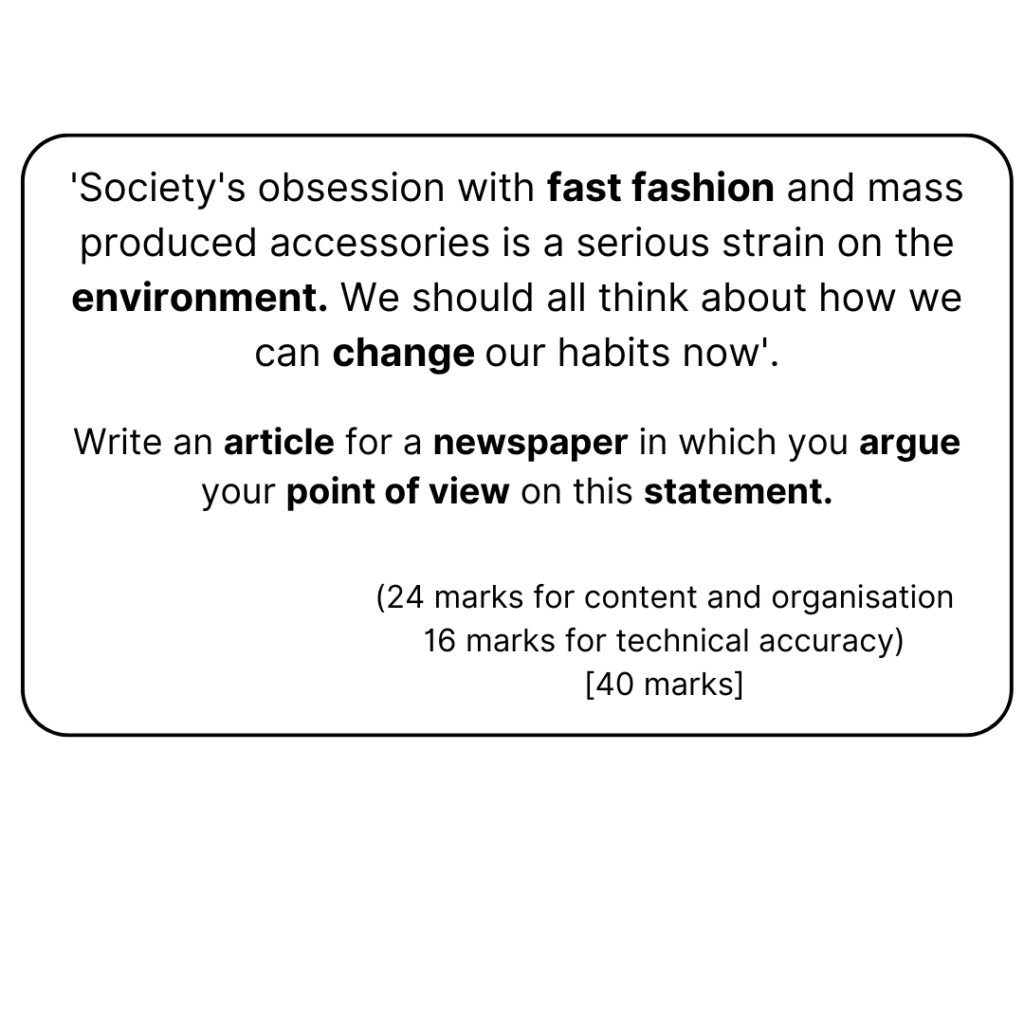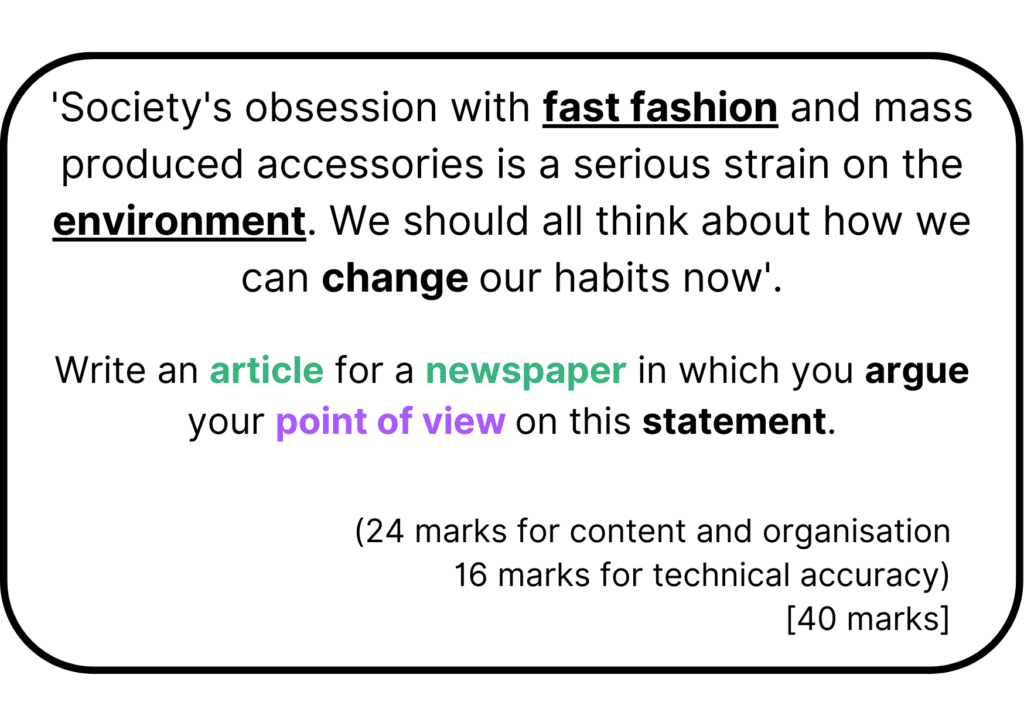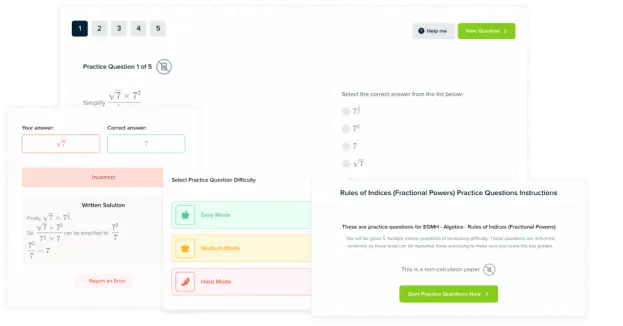AQA: Paper 2 Question 5
AQA: Paper 2 Question 5 Revision
AQA: Paper 2 Question 5
This page will provide some top tips to ensure that you are prepared for Question 5 of Paper 2.
Here, you will find out:
- The format of the question
- How to approach answering the question
- The Assessment Objective (AO) of the question
- A model answer that demonstrates what is expected
Assessment Objective
Question 5 is covered by both AO5 and AO6.
For AO5 you are required to:
- Communicate clearly, effectively and imaginatively, selecting and adapting tone, style and register for different forms, purposes and audiences.
- Organise information and ideas, using structural and grammatical features to support coherence and cohesion of texts.
For AO6 you are required to:
- Use a range of vocabulary and sentence structures for clarity, purpose and effect.
- Have accurate spelling and punctuation.
Question Format
Let’s have a closer look at what Question 5 of Paper 2 will entail…
For Question 5, you will be given a statement on the theme of the paper and asked to write a response to it…

It might be to discuss the statement for example, or maybe to argue for or against it.
The question will specify a format for you to use, like a newspaper article or letter, so it’s important to be aware of the structural features associated with different types of text.
For example, if you were required to write a letter, you should include an appropriate greeting and sign-off, as well as a recipient and sender address to show the examiner you are aware of the correct format.
What are the key terms in this question?…
Key Terms in Question 5

One key thing to look for in the question, specifically the statement you are given, is the theme of the question, which is underlined in this example.
This will be the content of your answer, and can give you idea of some language techniques to use in your answer.
For example, in this question you could use emotive language as climate change is a controversial issue.
Another thing to consider, which we’ve touched on briefly earlier, is the format of your question, highlighted in a green colour.
The question will explicitly tell you which format to use, which gives you an idea of some structural or formatting techniques you might use in your answer.
For example, in this question you could use a heading, subheading and maybe even format your work into columns to ensure it’s clear to the examiner you know how to fulfil the organisation element of AO5.
Finally, an important thing to look out for in the question is the aim or the purpose of your answer.
For example, this question is asking for you to argue your own point of view. This doesn’t have to be what you really think, but the question is asking you for an opinion on the subject.
Phrasing of Questions
Other styles of Question 5 may ask you to ‘discuss‘ the statement given to you, which means you need to consider both sides of the argument.
For example, you might be asked to discuss the statement: ‘The 4 day working week is better for the economy’.
In these cases, the statement will usually be a broad enough for there to be either a ‘for and against’ argument, or multiple points of view on an issue to discuss in your answer.
Remember, despite the phrasing changing in some questions or the format being different, the Assessment Objectives that Question 5 tests remain the same.
Keep in mind the key parts of AO5 and AO6 when constructing your answer; communicating clearly and imaginatively with a wide vocabulary, having a good understanding of form, structure and tone as well as organising information clearly and making sure your SPaG is up to scratch.
Having these in mind will make you feel confident so that you achieve high marks in your exam, no matter the format, theme or aim of the question thrown at you!
Mark Distribution
The marks in Question 5, Paper 2 are split as follows:
- 24 marks for content
- 16 for technical accuracy
This can be easily applied to the Assessment Objectives, so 24 marks for AO5 and 16 for AO6.
While this split may seem daunting, both Assessment Objectives are assessed throughout the question!
‘Technical accuracy‘ is what we discussed earlier: the specification of AO6 to have accurate spelling, punctuation and grammar and use of a range of sentence structures to properly structure and present your work.
Timings
Section B of Paper 2 is the writing portion of your English Language GCSE exam.
Let’s have a brief refresher of what Paper 2 entails as a whole…
Paper Two: ‘Writers’ Viewpoints and Perspectives’
50% of GCSE
1hr 45 mins
80 marks
And now, a breakdown of Section B…
Section B
Writing– 40 marks available
1 extended question
24 marks for content
16 for technical accuracy
As you can see, the writing question accounts for half of the marks in the exam.
Taking into account planning and checking time, you should aim to allow around 45 minutes to write your answer.
It’s important to plan your time well on the reading section to make sure you have enough time to tackle the writing question.
How To Approach The Question
As you have read on other AQA question pages for Paper 2, reading the question through carefully, and highlighting the key points is your starting point.
This is a longer writing question, so you can spend 5 minutes beforehand to plan your answer.
This could take the form of a mind-map of key ideas or a bullet-pointed list of techniques to use. It can also be helpful to number your ideas to structure your answer in a specific order.
Keeping in mind the type of text, perhaps you could make a note of some key formatting features to use in your answer.
Example: Extract from a Model Answer
Here, the format of your answer should be a letter, and the theme is social media use and its effects on people’s lives.

This informs your language choice as more formal as it’s a letter to a local newspaper for an unknown audience.
Format wise, you will need a greeting and sign-off as well as a recipient and sender address (you can make these up!).
It’s okay to make up the facts or address you might use in your letter, but here think about one opinion you can give.
In this example, you are being asked ‘whether or not you agree with this view‘.

Why is this a good answer?
The yellow highlight indicates the formatting choices made by the learner. Here, the greeting as well as the sending and recipient addresses are good points towards the organising information portion of AO5.
The green words are examples of emotive language, implying that social media is dangerous, making the learner’s opinion very clear to the examiner.
This would count towards the content section of the marks, therefore fulfilling the AO5 requirement that you adapt your tone for the purpose and form required.
However, it also counts towards the technical accuracy marks as these words fulfil the AO6 requirement, that you use sophisticated vocabulary which is spelled correctly.
The orange words are examples of language and structural techniques you could use in a persuasive letter.
Repeated rhetorical questions are impactful and imaginative uses of structure (AO5), and the use of short sentences for effect gets you AO6 points for using a range of sentence structures!
As you can see, despite the mark split in this question, it is easy to get marks from both AO points if you use your language and structural techniques correctly and effectively!
Remember this is only an extract of an answer- your answer in the exam will need to be longer!

MME Premium Membership
£19.99
/monthLearn an entire GCSE course for maths, English and science on the most comprehensive online learning platform. With revision explainer videos & notes, practice questions, topic tests and full mock exams for each topic on every course, it’s easy to Learn and Revise with the MME Learning Portal.
Sign Up Now


